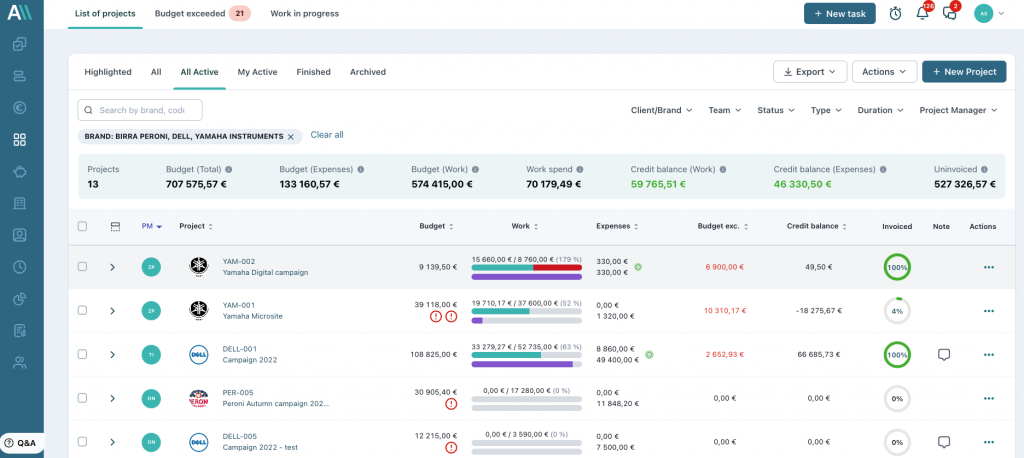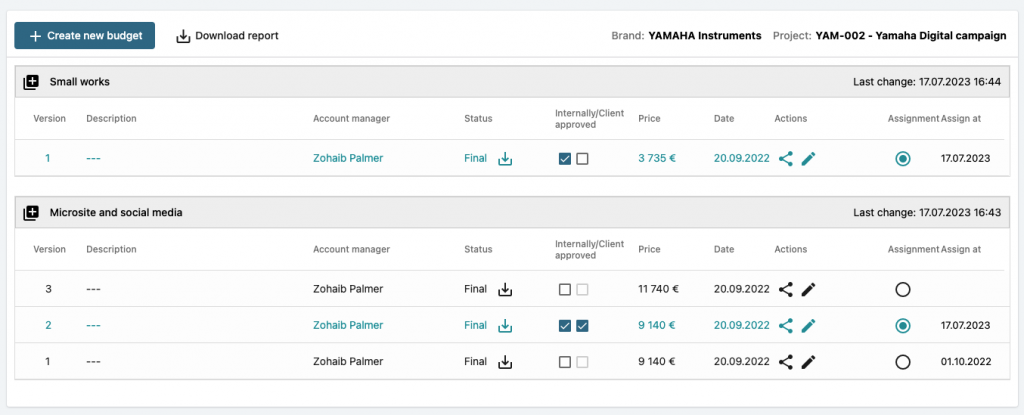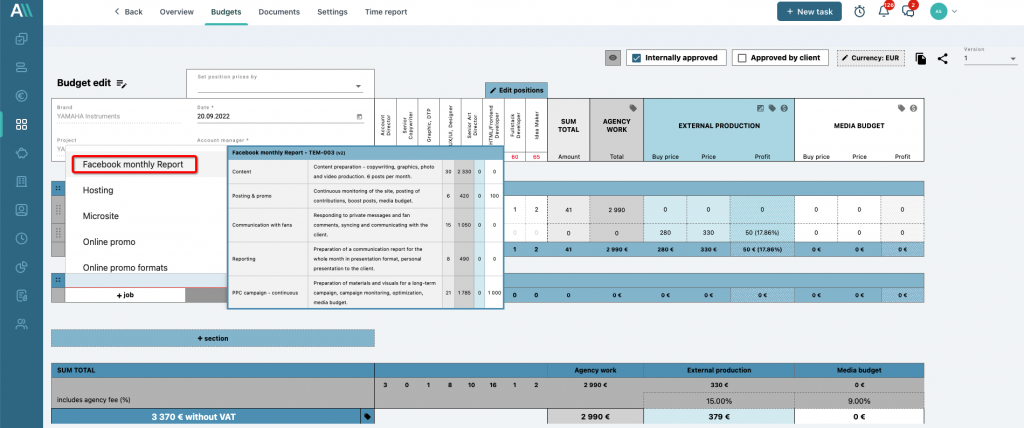There’s a common misconception that merely listing your social media costs in a basic Excel or Google Sheets budget document is sufficient for effective management of your social media budget.
Bad news: it isn’t.
To effectively allocate resources and make a real impact, a social media budget requires a strategic combination of these components:
- Staffing and labor costs
- Content creation and production costs
- Marketing tools
- Paid advertising
- Legal and compliance costs
- Unexpected costs
Let’s take a closer look at them.
To start with, do you even need a social media budget?
Resounding YES! An effective social media strategy involves much more than just posting content. It requires time, effort, and, most importantly – money.
A social media budget will give you the resources needed to create engaging content, develop targeted advertising campaigns, and invest in social media tactics that hook your audience. Securing a budget for social media should be one of the utmost priorities in your marketing plan.
When you have a budget in place, you can forget about the question left unanswered: “How much money should I spend?” You’ll just know, and so will everyone else involved in the process.

Key components of a social media budget
Crafting a budget is like putting together a puzzle. To make it work, you need to find and keep an eye on all of the necessary pieces. So now it’s time to break the costs into smaller parts and explore the “how” of budgeting for social media.
Staffing and labor costs
Creating a social media campaign requires effort and resources – it doesn’t just happen on its own. This often involves hiring personnel. Do you already have a marketing team on hand?
If you don’t have a marketing team yet, think about hiring a freelancer or outsourcing the entire project to an external agency. Even though it may seem expensive, a professional approach is better than taking risks with a DIY social media marketing strategy.
But staffing costs don’t end here. Budgets for human resources should include:
- Salaries for your social media team
- Costs associated with hiring contractors and freelancers (such as boards or recruiting agencies)
- Benefits expenses (such as health insurance, vacation time, and training, etc.)
Some of them you might not associate with social media campaigns straight away, but they all count towards your budgeting.
Content creation and production costs
Now, social media is all about videos. Viewers are constantly exposed to interactive content.
So, it shouldn’t come as a surprise that videos go along with some results too. Video content is number #1 – video ROI is better than for other types of content. It does, however, involve one negative aspect. The costs associated with creating video content are usually much higher than, e.g., those related to taking or editing photos. They can be even higher when you want to use animation or personalized shots.
And, usually, publishing more often means higher content creation costs.
Most brands share Instagram social media posts a minimum of 2-3 times per week. If you want to minimize the costs, you can consider user-generated content. People love to share their own experiences, so this is a great way to get content for free. However, you still need to account for your time (i.e., cost) spent on researching and curating content.
Marketing tools
Today’s social media marketers must have access to tools that can substantially increase their productivity. As part of their marketing technology stack, the average marketing team uses between 5-10 tools. Hardly any one of them can imagine managing marketing efforts without:
- a solid social media management tool (e.g., Kontentino),
- graphic design software (e.g., Canva),
- a video maker/editor tool (e.g., Biteable),
- media monitoring tools (e.g., Brand24),
- live chat/chatbot software (e.g., Smartsupp),
- automation tools (e.g., Zapier)
- social media budgeting tool (e.g., Allfred.io)
Looking for even more tools to power up your toolbox? Check our curated listicle of social media automation tools.
Social media marketers use tools for all sorts of tasks, and daily at that. Can you imagine doing all that work manually? That’s precious time you could be using to come up with brilliant creative ideas! That’s why it’s so important to include all the tools and subscriptions your team uses in your budget plan.
**Tip!** Creating a budget for social media marketing can be a bit of a headache. But with a robust social media budgeting tool, it’s as easy as pie!
Budgeting tools can work wonders to help you get the most out of your social media budget. They usually have a dashboard that shows you your expenses and where you could tighten things up a bit. It’s like having a personal organizer for project budgets, keeping track of expenses, and making sure resources go exactly where they should.

Paid Advertising
Paid advertising, as the name indicates, is paid. This part of the budget pops right into your head when you think about where your money’s going. But forecasting? Now that can get a bit tricky, especially if you’re trying to keep up with all the platform-specific ad spend criteria.
So, here’s the game plan for paid ads: don’t just throw sales pitches at your audience, give them valuable content they’ll love. That’s strategic thinking!
Say you’re throwing your ad dollars mainly at Instagram. You’ll want to look up some benchmarks for your IG budget. With a price of $0.20-$2.00 per click, you might be talking and thinking hundreds, not dozens, of dollars. In the case of Facebook, it’s about $0.94 per click.
Legal and Compliance Costs
Navigating the legal and compliance labyrinth when managing your social media presence can be a bit of a challenge, especially if you’re dabbling in different markets.
While it’s not the most thrilling topic, you’ve got to keep an eye on this one. Make sure all your social media activities are on the up and up with all relevant laws and regulations. Trust us: the cost of letting this slide could quickly outweigh the benefits of a well-thought-out social media budget plan.
For example, let’s assume that you want to leverage influencer marketing and sign a contract with a particular influencer. You’ll have to consider the cost of preparing and executing the contract, as well as verifying that all of the necessary paperwork is filed correctly.
And what about invoicing? Did you remember to list the influencer as an independent contractor? All these things can add up pretty quick and eat into your budget. Not to mention the cost of drawing up the campaign guidelines and the fee you’ll need to pay the influencer.
Unexpected Costs
Sometimes, things just don’t go as planned. In a social media budget, these hiccups can cost you.
Maybe that last Facebook advertising campaign didn’t quite hit the mark and you need to shell out some extra cash to pivot your strategy. Or your brand gets caught in a Twitter tornado and you need to call in the crisis management team ASAP.
It’s smart to have a bit of a cushion for these unexpected expenses when working out your social media budget, or you might find yourself in a tight spot. Better safe than sorry, right?
Luckily, there are tools that can help. Some budgeting tools send you a heads up as soon as you go over budget. You can keep track of your credit balance and clearly see which part of the project needs a bit of reigning in.

How to properly allocate a social media advertising budget?
The list of things to consider when managing a social media budget is quite long, but you can start with the following simple steps to plan your digital marketing budget properly.
#1 Set goals
No goals = no plan. You should definitely have SMART (Specific, Measurable, Achievable, Relevant, and Time-Bound) social media goals in place to treat them as your indicators for success. They will guide you in the right direction and show you the way in which you should develop your social media actions.
For example, if you want to grow your follower base, you should allocate some budget for brand awareness campaigns. But if you need to launch a new series of products and boost sales, you might be better off proceeding with pay-per-click (PPC) campaigns straight away.
#2 Focus your firepower
Concentrate your social strategy efforts on one area. Determine who your target audiences are and which social media networks they use the most. This will help you select the right channels to allocate your budget on.
Focus on one or two social channels in the beginning, then slowly expand your social marketing reach. For example, you might pick Facebook News Feed adverts to try out first, and if they bring you the results you expected, you can either double the budget on them, test other placements, or spend money on a totally different social media platform then. At least you have data to lean on.
But if you pick a lot of platforms straight away, you might struggle with managing and optimizing your activities in many places at the same time.
So the conclusion is simple: don’t spread all your efforts too thin.
#3 Test and learn
To achieve the best results, you should constantly experiment with different ad formats, placements, and social media content. Running multiple campaigns in tandem (if your resources allow – read the previous point!) can help you test what works best and optimize your budget allocation for maximum ROI. Keep a watchful eye on each campaign’s performance and adjust your budget accordingly so that you can capitalize on success and minimize social media spending.
Don’t waste your time (and money) on campaigns that just don’t deliver – change your budget distribution or pause the campaign altogether. You can also use data from past advertising efforts to guide future decisions. By doing so, you’ll be able to save precious social media dollars and boost your return on investment.
Tips for optimizing your social media budget and workflow
These little tips are here to help you optimize your social media workflow – use them as general guidelines to get going from day one.
Tip 1: Streamline budget proposal process
Everybody knows those tedious emails, papers, and approval letters associated with budget changes. How about simplifying this process with a few clicks? Actually, it’s already possible.
You can use social media budgeting tools that provide a separate tab for budget proposals where you can edit, share, or see their statuses (budgets can easily be marked as internal or client-approved).

Tip 2: Capitalize on templates
Marketers love templates. They help us all save time, boost productivity, and maintain quality. With presets, creating visuals becomes a breeze. But when it comes to budgets, the fun is lost. So what if you could also create budget templates or use shared agency know-how? It will let you input data with ease so you never have to bother with creating the same patterns again.

Allfred lets you store your budget templates too.
Tip 3: Use automation (wisely)
Being a social media manager can be challenging – you definitely have a lot of tasks on your plate. Automation tools are here to save the day, giving you some hints and streamlining mundane tasks so you can take care of strategic plans and tactics.
And now, in 2023, you can combine your favorite tools and apps via integrations. A lot of apps can integrate with Asana and Slack giving you a full overview of your creative/executive parts. That’s just on top of the many options you have to hand, all for the sake of boosting your productivity and overall performance.
Tip 4: Create a budget planning cycle
It’s not a “set and forget” activity, but it’s not a one-off either. Your budget planning should resemble a cycle that helps you manage your business more efficiently, has repetitive patterns, but is equally open to modifications. Many small businesses create their budgets at the beginning of the year and then forget about them altogether.
However, a budget is much more than a mere document with numbers – it is a dynamic entity that needs constant changes. Keep your budget cycle rolling and react to bottlenecks as soon as they arise.
Get your social media budget under control
Setting up your social media budget is just one part of the story. A very important one, don’t get us wrong, but it’s rather the running, adjusting, executing, and, often cutting of the budget that makes the whole process particularly difficult.
We hope that with a handful of our tips, it will be a bit easier for you to get started and evaluate your efforts through the prism of your spending. With a well-managed budget comes a well-managed strategy, and vice versa.




